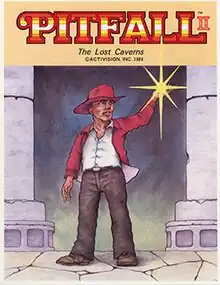Pitfall II: Lost Caverns (arcade game)
Pitfall II: Lost Caverns is a 1985 arcade game developed by Sega. It was based upon Activisions two home console games Pitfall! (1982) and Pitfall II: Lost Caverns (1984) for the Atari 2600. It was described by historian Brett Weiss as a "rare occurrence" of an Arcade game being influenced by a console game.[1]
| Pitfall II: Lost Caverns | |
|---|---|
 European arcade flyer | |
| Developer(s) | Sega |
| Publisher(s) | Sega |
| Series | Pitfall! |
| Platform(s) | Arcade |
| Release | |
Gameplay
Pitfall II: Lost Caverns focuses on Pitfall Harry locating three treasures hidden in large caverns. The player must maneuver the character within a time limit to earn extra points and additional playtime. When Pitfall Harry interacts with a key, a hope opens which allows the player to continue into a new cavern allowing for bonus points and more time allotted on the timer.[2]
Production and release
Sega licensed the Pitfall name from Activision to develop Pitfall II: The Lost Caverns.[2] The arcade combines elements of both Pitfall! and Pitfall II: Lost Caverns as well as introducing unique obstacles such as lightning and volcanic rocks.[1]
Pitfall II: The Lost Caverns was released to Japanese arcades in February 1985.[3] In Japan, Game Machine listed the Sega arcade remake of Pitfall II: Lost Caverns on their March 1, 1985, issue as being the most successful table arcade unit of the month.[4] It was released in the United States by Sega USA in May 1985.[5] The game was among Sega USA's earliest releases, which were games that were no longer turning a profit in Japan. It was not a significant hit in Sega USA's market.[6]
Reception
From contemporary reviews, Computer and Video Games declared the game to be "as good as, if not better than" the original Atari 2600 games.[7]
References
- Weiss 2014, p. 171.
- Pitfall II - The Lost Caverns (arcade flyer). Sega. 1984. Retrieved June 12, 2023 – via Archive.org.
- "ピットフォール 2". Media Arts Database (in Japanese). Agency for Cultural Affairs. Retrieved June 12, 2023.
- "Game Machine's Best Hit Games 25 - テーブル型TVゲーム機 (Table Videos)" (PDF). Game Machine (in Japanese). No. 255. Amusement Press, Inc. 1 March 1985. p. 21.
- Akagi 2006, p. 131.
- Horowitz 2018, p. 86.
- "Arcade Action". Computer & Video Games. No. 46. August 1985. p. 108. ISSN 0261-3697. Retrieved June 12, 2023 – via Archive.org.
Sources
- Akagi, Masumi (2006). "海外編" [Overseas Edition]. アーケードTVゲームリス 国内 • 海外編 ( 1971 - 2005 )ト [Arcade TV Game List Domestic/Overseas Edition (1971-2005)] (in Japanese). Japan: Amusement News Agency. ISBN 978-4990251215.
- Horowitz, Ken (2018). The Sega Arcade Revolution: A History in 62 Games. McFarland & Company, Inc. ISBN 978-1-4766-7225-0.
- Weiss, Brett (2014). The 100 Greatest Console Video Games 1977-1987. Schiffer Publishing. ISBN 978-0-7643-4618-7.